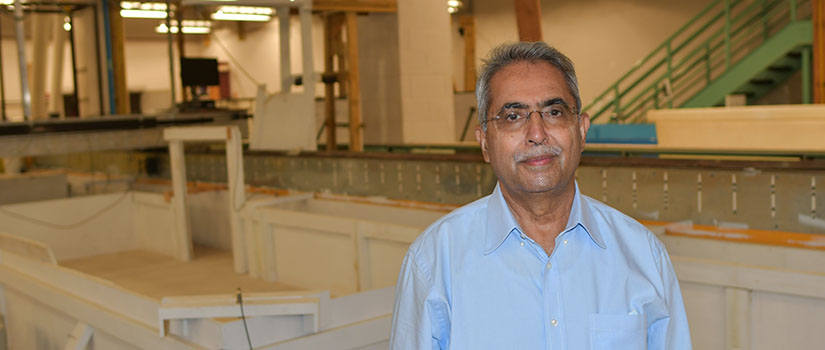Civil engineering researcher Hanif Chaudhry to lead UofSC team contributing hydraulics expertise to NOAA-funded project
The University of South Carolina is lending its expertise in hydraulics, river and stream modeling to a hydrologic project that has been awarded $360 million by the National Oceanic and Atmospheric Administration (NOAA).
The efforts of the consortium, which includes 27 other academic institutions, non-profit organizations, and government and industry partners from the U.S. and Canada, have established the Cooperative Institute for Research to Operations in Hydrology (CIROH). The institute will develop and distribute national water analyses, forecast information, additional data, guidance, and support services to inform essential emergency management and water resource decisions.
While the NOAA project will be spearheaded by The University of Alabama Water Institute, UofSC has complimentary expertise and facilities in its College of Engineering and Computing led by faculty Hanif Chaudhry, Jasim Imran, Enrica Viparelli, and Erfan Goharian. Chaudhry has extensive expertise in hydraulics, as well as river and stream modeling which enables the accurate representation of physical characteristics and structures like bridges, culverts and levees related to river flow. These models assist in calculating the potential extent of flooding. UofSC’s hydraulics lab will be used for this work and testing.
“This partnership will be an excellent opportunity for faculty and students to collaborate with so many other institutions. It will be a win-win for everyone,” Chaudhry says. “We will produce research findings which will be used nationally and internationally for very critical situations in water infrastructure, providing more accurate tools that can be used more confidently to predict and prevent natural disasters.”
Two years ago, Chaudhry was appointed by the governor to serve on the South Carolina Floodwater Commission, and he is also a principal investigator in a $4 million project funded by the U.S. Army Engineer Research and Development Center. His ongoing research focuses on the use of biopolymers to strengthen earthen infrastructures, and the information gathered from this project will aid the UofSC team in contributing to the consortium.
“We’re looking forward to the collaboration with others and contributing to NOAA’s overall objective of this project. It will be good for us to come on the national scene as one of the players in doing big projects,” Chaudhry says.
CIROH will advance water research in support of NOAA’s Office of Water Prediction and reinforce the work of the National Weather Service and National Water Center through collaboration across the scientific community in four broad research themes:
- Water resources prediction capabilities
- Community water resources modeling
- Hydroinformatics
- Application of social, economic and behavioral science to water resources prediction
As was the case with South Carolina’s historic 2015 floods, billions of dollars in infrastructure damage, as well as human harm and death can occur. Climate change is expected to worsen these adverse conditions. The research findings of the NOAA hydraulic project will result in improved prediction capabilities and will be of great interest for South Carolina emergency preparedness and management.
“The availability, access and control of water is central to the quality of life and health of the planet,” College of Engineering and Computing Dean Hossein Haj-Hariri says. “The magnitude of the problem demands a collective approach which can only be enabled by significant funding. Such large and collaborative programs provide the best platform for educating the next generation of researchers, and we are delighted to be contributing to this activity.”
CIROH will also create programs for consortium members and partners to train the next generation of water professionals. Local-to-national scale workforce training programs will translate CIROH advances into practice, and extensive outreach and engagement will connect CIROH to stakeholders helping communities build resilience to water-related risks.
CIROH’s 14 consortium members include: The University of Alabama; Brigham Young University; Colorado School of Mines; Tuskegee University; The University of Alabama in Huntsville; University of Arizona; University of California San Diego, Scripps Institution of Oceanography; University of Hawai‘i at Mānoa; University of Iowa; University of Minnesota, Twin Cities; University of Saskatchewan; University of Utah; University of Vermont; and Utah State University.
Consortium partners include: University of South Carolina, Baron Weather Inc.; Coastal Carolina University; Consortium of Universities for the Advancement of Hydrological Science Inc.; Dauphin Island Sea Lab; Gulf of Mexico Coastal Ocean Observing System; Jupiter Intelligence; New Mexico State University; Oak Ridge National Laboratory; The Pennsylvania State University; RTI International; Stevens Institute of Technology; University of California, Davis; and University of Illinois at Urbana-Champaign.
